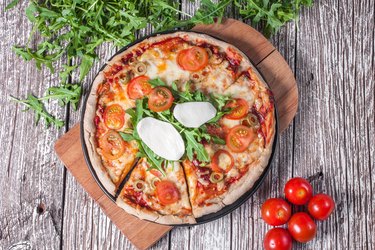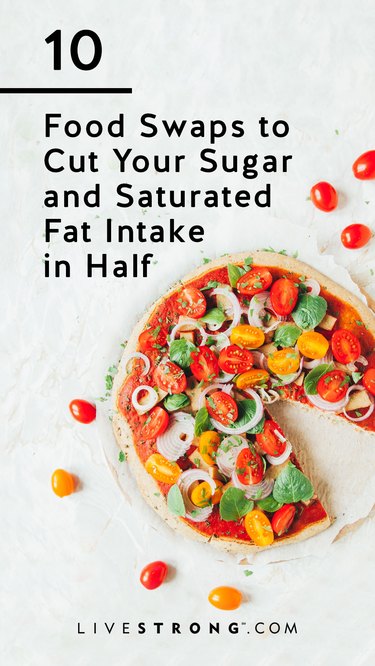
Most public health recommendations plead that we fill our plates with more whole grains instead of refined ones and limit our saturated fat intake to no more than 10 percent of total calories. While these guides have been in place for years, it appears we're still far from heeding them.
Indeed, a large study of nearly 44,000 adults found that 42 percent of our calories each day are coming from low-quality carbs (think: french fries, soda and baked goods) and 12 percent of our calories are coming from saturated fat (like red meat, butter and full-fat dairy), per September 2019 research published in the Journal of American Medical Association (JAMA).
Video of the Day
Video of the Day
Researchers noted that while they did see slight improvements compared to previous years, we're still far from scoring an A on this report card. So how do we bump up our healthy-eating GPA?
Instead of totally cutting out the foods we love and have grown accustomed to, consider making healthy swaps instead. Here are some ideas to help you cut down your intake of low-quality carbs and saturated fat — without sacrificing too much.
5 Healthy Swaps for Sugary Foods

1. Substitute Soft Drinks for Sparkling Water
There's nothing redeeming about soft drinks — they're loaded with added sugars. While some might think diet soda would be a healthier swap, this hasn't proven to be the case.
Diet soda has been linked to heart disease, diabetes, an altered gut microbiome and no improvement when it comes to kicking the sugar habit, according to Harvard Health Publishing. Switching from a 12-ounce can of soda to a 12-ounce bottle of sparkling water saves you 39 grams of added sugars.
Brands We Love
- Spindrift ($14.94 per 24-pack on Amazon.com)
- Bubly ($5.91 per 18-pack on Amazon.com)
- Perrier ($13.48 per 24-pack on Amazon.com)
2. Go for Plain Yogurt Over Flavored
Fruit-on-the-bottom, sugary mix-ins and the like are what make a lot of yogurts a lot less healthy than you think. For example, a standard 5.3-ounce cup of low-fat, vanilla-flavored yogurt usually packs in 22 grams of sugar while the same serving of plain, low-fat yogurt has only 10 grams of sugar.
That might still sound like a lot — but keep in mind that lactose, a sugar naturally found in dairy, is also lumped into that total sugar count.
Brands We Love
- Siggi’s ($1.37 per container on Amazon.com)
- Chobani Less Sugar ($0.90 per container on Amazon.com)
3. Try a Healthier Ice Cream
This one is a double-whammy because ice cream is high in added sugar and saturated fat. But the good news is that the ice cream market has been booming with innovation recently — resulting in healthier options so we can have our ice cream, and eat it, too.
Many of the newer products use monk fruit or stevia to cut down on added sugars or feature milk alternatives which helps to reduce saturated fat while keeping them plant-based.
For instance, a half-cup serving of traditional, dairy-based vanilla ice cream contains 14 grams of sugar while the same serving size of Halo Top Vanilla Bean boasts 6 grams of sugar.
Another option is to DIY your own at home with your favorite no-added-sugar "nice cream" recipes.
Brands We Love
- Halo Top ($3.88 per container on Amazon.com)
- So Delicious Vanilla Bean Coconutmilk Frozen Dessert ($4.99 per container in stores)
4. Swap White Bread for Sprouted Bread
White bread might bring back nostalgic childhood memories, but that's exactly where it should be left — in the past. Not only is white bread typically stripped of all of the grain's nutrients like when fiber, vitamins and minerals, but it frequently sneaks in added sugar, too.
Case in point: A slice of classic white bread typically serves up about 2 to 3 grams of sugar and little to no fiber. Instead, opt for a sprouted-grain bread, which usually boasts around 0 to 1 gram of sugar and 3 to 5 grams of fiber. Plus, sprouting the grains also boosts the amount of B vitamins, vitamin C, fiber and amino acids, according to the Whole Grains Council.
Brands We Love
- Angelic Bakehouse 7-Grain Sprouted Bread, No Added Sodium ($4.99 per loaf on Angelicbakehouse.com)
- Food for Life Ezekiel 4:9 Flax Sprouted Whole Grain Bread ($4.99 per loaf on Amazon.com)
5. Opt for Low-Sugar Breakfast Cereals
Breakfast cereals are quite often high in added sugar and refined grains. Instead, make your first meal of the day count by choosing a lower-sugar, whole-grain option.
For example, although Honey Nut Cheerios is touted as a healthy, whole-grain cereal, one cup will cost you 12 grams of sugar. However, similar picks from different brands contain half the sugar — which is why reading labels is key!
Brands We Love
- Bob’s Red Mill 10-Grain Hot Cereal ($6.89 per pack on Amazon.com)
- Nature’s Path Organic Whole O’s ($50.71 per 6-pack on Amazon.com)
- purely elizabeth. Superfood Oatmeal (10.61 per pack on Amazon.com)
5 Healthy Swaps to Cut Down on Saturated Fat

1. Enjoy Low-Fat Cheese Over Full-Fat
Full-fat cheese is just that: full of fat. But you can still enjoy cheese as long as you choose wisely. Shop for low-fat cheeses made with non-fat or low-fat milk, with no more than 3 grams of fat per ounce and no more than 2 grams of saturated fat per ounce, the American Heart Association recommends.
Cottage cheese is a perfect example. A half-cup of full-fat cottage cheese clocks in at 3 grams of saturated fat while the same serving size of the low-fat version steals the cake with 1.5 grams of saturated fat.
Brands We Love
- Horizon Organic Low-Fat Cottage Cheese ($6.49 per 16-ounce tub on Amazon.com)
- Mini Babybel Light Cheese ($3.99 per pack on Amazon.com)
- Laughing Cow Light Swiss Cheese ($2.87 per pack on Amazon.com)
2. Swap Cheese Pizza for a Veggie Slice
To slash your saturated fat intake, you don't have to cut out pizza altogether. Instead, choose a veggie-topped slice with tomato sauce and skip the cheese. You'll not only cut down on unhealthy fat but you'll also add fiber and nutrients to your plate thanks to the vegetables.
A third of Amy's Cheese Pizza pie has 5 grams of saturated fat while the same serving of the brand's roasted vegetable pizza only provides 1.5 grams saturated fat.
Brands We Love
- Amy’s Roasted Vegetable Pizza ($6.34 per pie on Amazon.com)
- Sweet Earth Veggie Lover’s Pizza ($6.49 per pie on Target.com)
3. Make Turkey and Chicken Your Go-Tos
Sausage and burgers are typically made with a high-fat beef or pork. Instead, look for a leaner cut of meat made of lean beef, turkey or chicken.
A great example is switching from a pork sausage like Aidell's Cajun Style Andouille sausage with 4 grams of saturated fat to a chicken sausage that boasts just 1.5 grams of saturated fat. And don't fret; these lower-fat versions aren't lacking in flavor. Many of the store-bought options incorporate a slew of herbs and spices.
Brands We Love
- Applegate Organic Chicken and Apple Sausage ($8.99 per 12-ounce pack on Amazon.com)
- Applegate Great Organic Turkey & Mushroom Blend Burger ($8.99 per 12-ounce pack on Amazon.com)
4. Swap Whole Milk for a Reduced-Fat or Dairy Alternative
A cup of whole milk has 5 grams of saturated fat, but you can cut that by more than half if you go with a low-fat (1.5 grams saturated fat) or fat-free (0 grams saturated fat) milk.
Another option: Plant-based milks (not including coconut milk) typically have little to no saturated fat whether you go almond, oat, flax or soy. Just be sure to look for an unsweetened carton to avoid added sugars.
Brands We Love
- Organic Valley 1% Milk ($4.19 per half-gallon on Amazon.com)
- Silk Unsweetened Organic Soymilk ($2.58 per half-gallon on Amazon.com)
5. Cook With Plant Oils Instead of Butter
While they're pretty comparable when it comes to calories — one tablespoon of butter contains 100 calories while one tablespoon of plant-based oil has around 120 calories — the same cannot be said for their saturated fat contents.
Butter has 7 grams of saturated fat for that same serving size while olive oil has 2 grams, avocado oil has 1.6 grams and grapeseed oil, just 1.3 grams.
Making this swap is a heart-smart idea: Using just over half a tablespoon of olive oil a day (instead of animal fats such as butter) is associated with a 14-percent lower risk of cardiovascular disease and an 18-percent lower risk of coronary heart disease, according to an April 2020 study in the Journal of the American College of Cardiology that looked at more than 90,000 Americans over a 24-year period.
Brands We Love
- California Olive Ranch Extra Virgin Olive Oil ($14.97 per 16.9-ounce container on Amazon.com)
- Laudemio Frescobaldi Extra Virgin Olive Oil ($49.99 per 16.9-ounce container on Amazon.com)
- Chosen Foods Avocado Oil ($9.99 per 8.4-ounce container on Amazon.com)
- Pompeian Grapeseed Oil ($13.83 per 68-ounce container on Amazon.com)

- USDA MyPlate: "10 Tips: Make Half Your Grains Whole Grains"
- Whole Grain Council: "Sprouted Whole Grains"
- American Heart Association: "Dairy Products - Milk, Yogurt, and Cheese"
- USDA Nutrient Database: "Whole Milk, Vitamin D"
- USDA Nutrient Database: "1% MilkFat Milk"
- USDA Nutrient Database: "Fat Free Skim Milk"
- USDA Nutrient Database: "Unsalted Butter"
- USDA Nutrient Database: "Olive Oil"
- USDA Nutrient Database: "Avocado Oil"
- USDA Nutrient Database: "Grapeseed Oil"
- Harvard Health Publishing: "New concerns about diet sodas"
- Journal of the American College of Cardiology: "Olive Oil Consumption and Cardiovascular Risk in U.S. Adults"